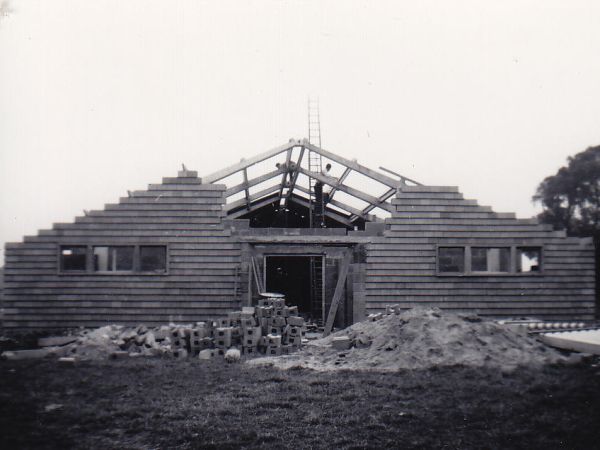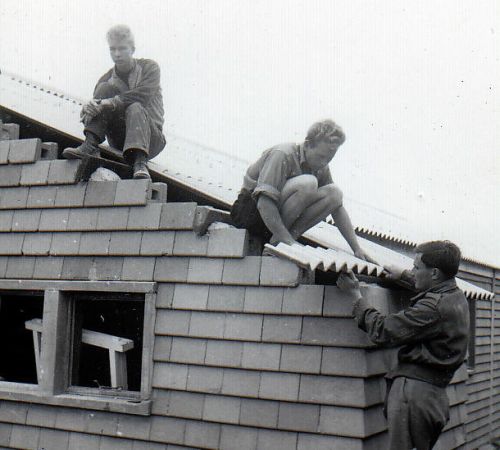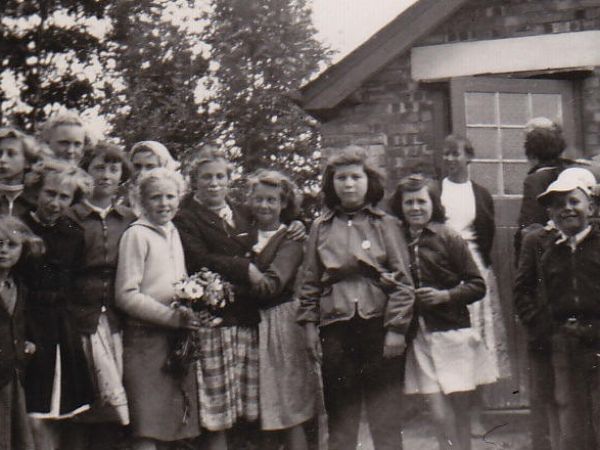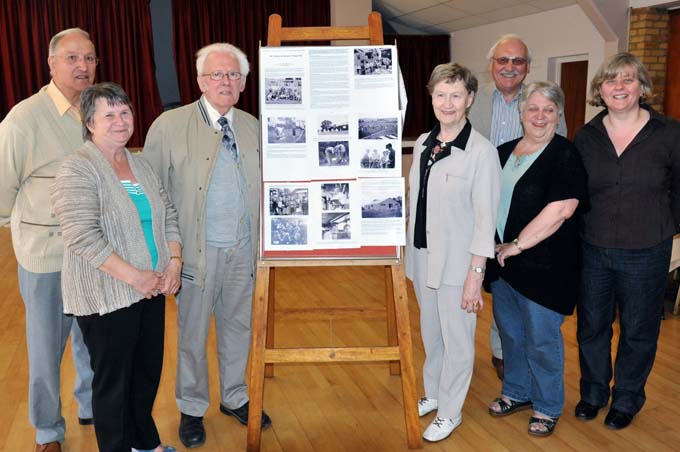History
The Hundon Village Hall was a Hundon project, conceived and started in 1955 and completed in 1957, but somewhere in early 1956 difficulties arose and it was realised that the task was perhaps greater than the villagers were going to be able to cope with, within a reasonable time. Consequently, through the offices of The Friends Work Camps Committee, in the summer of 1956, the village of Hundon was host to a score of young people from a number of different countries who lived together, worked together and played together, to build the Village Hall we have today.
The Hundon Village Hall
(A local project with international ramifications)
J Anthony Bristow
I am writing this more than fifty years after the events described herein. The text is not however based solely on my indistinct memories of the month when I was the leader of this international group. I have also had at my disposal considerable documentation of the preparations and the progress of the camp from day to day and an invaluable day by day log where the campers took it in turns to document what was happening together with their own thoughts and experiences.
For a month in the summer of 1956, the village of Hundon in the county of Suffolk was host to a score of young persons from a number of different countries who lived together, worked together, played together and talked together and were warmly welcomed by the local villagers with whom they interacted in dances, tea parties and social gatherings, leaving behind them an almost finished village hall and taking with them memories and lasting romance. But let me start at the beginning.

Campers gathered in front of the partially built building on the first morning, together with Mr Reginald Russell-Howes, the secretary of the village committee, (Photo: Suffolk Chronicle & Mercury)
The Hundon Village Hall was a Hundon project, conceived and started in 1955 and completed in 1957, but somewhere in early 1956 difficulties arose and it was realised that the task was perhaps greater than the villagers were going to be able to cope within a reasonable time. In this situation, it is my guess that someone amongst the local Quakers (Society of Friends) began to wonder whether this might be a situation where the Friends Work Camps Committee could be approached for assistance. The documentation available to me says that the local Quakers were informed but that the original contact was Mr B J Reid, the secretary of the Suffolk Rural Community Council and, whatever thebackground to this contact, it meant that the Hundon village hall became a part of something much bigger than a local building project, part of an international post-war activity striving for peace.
The work-camp movement
The Friends Work Camps Committee (FWCC) with its headquarters in London was a branch of theFriends Service Council, which less than a decade before in 1947 had been awarded the Nobel Peace Prize together with its American counterpart, the American Friends Service Committee, and it was committed to arranging international work camps bringing together young people from different countries to live and work together.
Towards the end of the second world war, it was realised that there would be a need for both reconstruction and reconciliation and that one step towards a more peaceful world would be to bring together young persons from different countries to live together and preferably also work together in order to create bonds and promote understanding. The Friends Work Camps Committee arranged its first work camp in 1948, but already in 1943, for example, Internationella Arbetslag [International Work Camps] (IAL) was founded in Sweden to join with other organisations to sponsor work camps and exchange volunteers, and in 1949 the Association of International Work Camps for Peace (AIWCP) was formed and defined its purpose as “building peace through small international groups of volunteers, working, living and learning together”.
In 1956 the Friends Work Camps Committee arranged half a dozen camps in England with about 80 participants, but the work-camp movement was by then far more than a few camps in Great Britain. In 1955, the AIWCP group arranged more than 80 camps in more than 20 different countries, sending volunteers to each other’s camps, and it is said that in 1954 worldwide as many as 69 283 volunteers took part in 1 859 camps. Much of this work, of which the Hundon project was thus one activity among many, has been described by Arthur Gillette in a book entitled One Million Volunteers, published by Pelican Books in 1968.
Preliminary arrangements
When a proposal for a work camp was received by the FWCC, an on-site assessment was made to determine whether a work camp was justified and feasible. It was not merely a question of ensuring that the task was such that the volunteer campers would consider it worthwhile, but also a question of accommodation, living conditions, catering etc. Since the young people taking part were not skilled craftsmen, it was essential to ensure that the tasks were suitable for unskilled persons and did not involve too much heavy work, that there was sufficient work available and that there were sufficient tools to ensure that all could be kept busy, not only to ensure that as much could be achieved as possible in the time available but also to ensure that the campers felt that their presence was worthwhile. The decision to have a camp in Hundon was made sometime in the spring of 1956, only a few months before the start.
Each camp was basically an autonomous unit making its own plans and decisions, but two persons were always appointed in advance: the leader and the caterer, and for the Hundon camp, these were I, Tony Bristow, and Jennifer Brown. My background was Congregational [Noe The United Reform Church] rather than Quaker, but when I accepted the invitation to lead the Hundon camp, I had just completed my period of service as a conscientious objector. As an alternative to military service, I had been with the Friends Ambulance Unit International Service, and I had spent the last eighteen months as leader of work-camp-like groups engaged in rebuilding work on the Greek islands of Cephalonia and Zakynthos which had been devastated by an earthquake in 1953.
The cost of the camp
The local people were expected to provide the materials for the job and also equipment such as cement-mixers, barrows and ladders, but the Friends Work Camps Committee also had a supply of tools at its disposal. In the early stages of the planning, the questions of tents and bedding arose, and the minutes of an early meeting record that in Hundon there was at any rate plenty of straw available for palliases [Palliasse – a thin mattress filled with straw or sawdust]
The participants paid their own travel expenses and found their own way to Hundon – not the easiest place to reach – and also provided their own pocket money. In addition, the British participants were asked to contribute to the cost of food, administration, insurance etc. which was then assessed at the sum of £1-12s-6d per week (£1-62½p). They were often sponsored by local churches or meetings and a surviving document shows that I, who at that time had few resources (for nearly three years I had been working with the Friends Ambulance Unit receiving an allowance of two guineas [1 guinea = £1-1s-0d] a month), was in fact sponsored to the sum of £6-10s-0d by the Spiceland Training Centre run by the Society of Friends in Saffron Walden, to be paid directly to the Friends Work Camps Committee at the end of the season.
The participants
Altogether there were 23 participants from eight nations [Denmark (2), Germany (3), Holland (1), Japan (1), Sweden (3), Switzerland (2), UK (9), USA (2)] , of whom 9 were from the UK. Some arrived late and some left early, but there were on average 21 participants throughout the period of the camp, which lasted a whole month from 30 June to 30 July. Altogether there were 13 men and 10 women. A precondition was that all applicants should be 19 years old or older and most of the participants were in their early twenties.
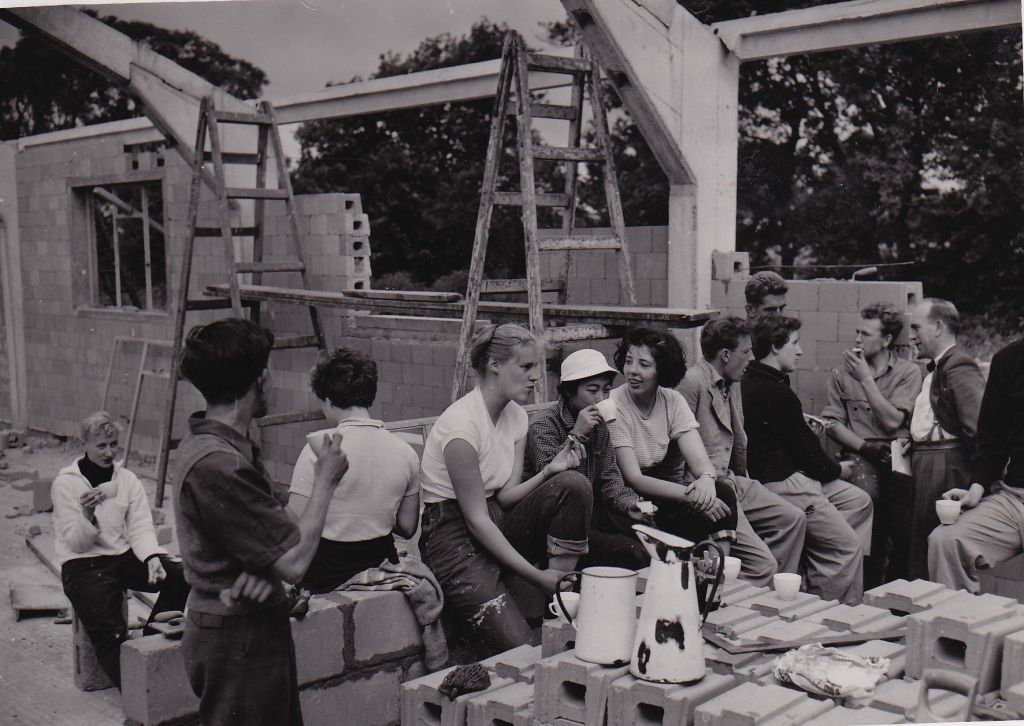
A mid-morning drink. Anne-Marie, Alan, Christine, Ingrid, Yoshi, Ruth, Knud, Friedrich, Aleid and Sven together with the architect
They all had a reasonable knowledge of English, and I do not remember that there were any major language difficulties, even though there were certainly misunderstandings which needed to be sorted out. As an aid in preparing this summary, I have a valuable source of information in the camp “log”, written by the participants, each of whom was allotted one or more days and all of whom took the task very seriously. It is worth mentioning that there were no serious accidents or illnesses during the period of the camp.
Living conditions
The conditions for the camp in Hundon were adequate but fairly primitive. The campers slept in bell tents erected in the field behind the village hall, but they also had the use of a men’s club building opposite to the site.
This building had electricity but no water. There were a couple of gas rings for cooking which were augmented for the duration of the camp by Calor-gas cookers. Pots and pans and other equipment were provided and, as the pictures show, carefully marked by FWCC. The billiard table in the club building was fitted with a protective cover for the duration of our stay and this provided a table for meals.
Toilets were of the Elsan chemical closet variety, and the male campers accepted the task of emptying these into a suitable hole at regular intervals. Special tents provided washing facilities, with water available from a tap across the road from the men’s club, and this supply of water facilitated hair-washing. People in the village provided opportunities for an occasional bath and also facilities for the campers’ laundry.
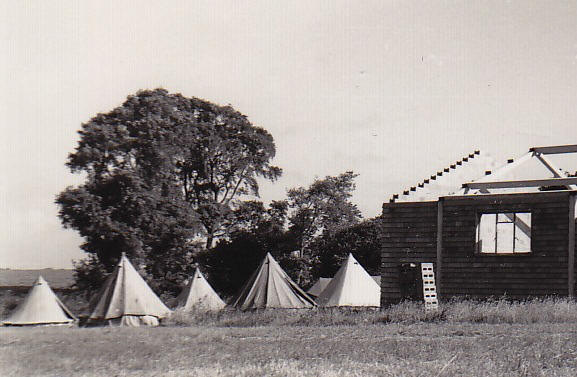

Aleid receives help washing her hair
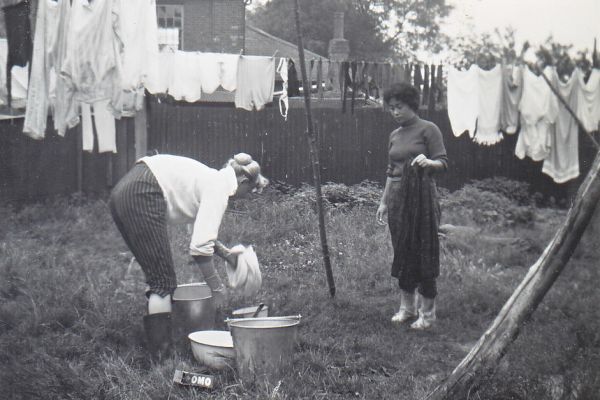
Anne-Marie and Yoshi tackle the laundry
The campers soon fitted into the camp life. On 4 July, David wrote that “by the end of three nights, territories in the tents had been securely claimed and the straw palliasses worn into reasonable shape”, and three days later, Ingrid wrote that “although the palliasse is a little hard during the night, it seems wonderful, yes quite irresistible in the morning”.
Jim noted on the second day that “the men had the privilege of shaving in cold water”, and it appears that they did indeed accept this “privilege”. The photographs taken during the course of the camp show clean-shaven faces with no sign of incipient beards or stubble.
Catering
Although Jennifer had the overall catering responsibility, everyone took part in the cooking. On each day, two people were assigned in alphabetical order to the kitchen and an overlapping rota was arranged so that each person spent one day with the previous day’s cook and one day with the next day’s cook. For these two, the day started early, getting up at 6.00 am to prepare breakfast at 7.00 am, so that the campers could be ready to start work at 8.00 am. A bell was rung outside the tents at 6.30 am so that no one needed to miss breakfast.

Jennifer and Jim prepare lunch

Alan, Ingrid, Aleid and Peter enjoy a meal
The available documentation shows that some bulk materials were obtained wholesale and were provided by FWCC. Other items such as bread and milk were obtained locally. The minutes of a preliminary meeting mention that Mr Farrant, a member of the Village Hall Committee, was in fact the local butcher, and meat was presumably purchased from him. Vegetables could also be purchased locally, but these were augmented by gifts from local farmers and gardeners.
In the camp log, there is little comment about the quality of the food and I can find little information about the menus, but the preliminary documentation refers to bulk wholesale purchases by FWCC of e.g. corned beef. The food seemed adequate and it was noted that some of the cooks took the opportunity to brighten up the menu with cakes and cookies. Other entries in the log refer to puddings, fish and Jenny’s gooseberry pies, and the surprise of the foreigners at encountering “welsh rarebit” for the first time.
The work done
The building had been partially erected when we arrived in Hundon, but there was still plenty to be done. At the same time, it was realised that, even with almost twenty man months of work, it would not be possible to finish the project. The goal was to get the interior walls finished, to get the roof on and to dig drains for the sewage system.
Although various events caused adjustments to be made to the time-table, the basic ambition agreed upon by the campers themselves was a 44-hour week. In the final report, it was noted that “a slight lack of punctuality in starting was outweighed by considerable voluntary overtime, although it may be that a stricter punctuality would have been more desirable”, but this was after all a voluntary holiday work-camp and not a sentence to a period of forced labour. In a letter written to me after the camp, the vicar, the Rev Arthur F Waskett, wrote that, in answer to a question from his son-in-law, he “was ableat once and in all sincerity to say that they did very well, worked hard and were a great help”.



Erecting the interior walls and doorways was a priority in the first week
For the unskilled and more menial tasks such as drain-digging, the work was shared in rotation, but most of the work was fairly skilled and it was more suitable for people to remain at tasks which could be their own responsibility; although even so most campers enjoyed a variety of jobs, a factor encouraged by the inevitable disruptions due to the cooking rota. In most cases it was possible to work in pairs. Unfortunately a delay in the arrival of materials caused a congestion during the second week, when the over-abundance of manpower was accentuated by the traditional shortage of tools. In the end, however, the extent of the final achievement benefitted from this early concentration on the internal partitions.
During the first week, the external walls were completed, the windows fitted, and the trenches for the drainage system dug while work was begun on the internal partition walls and various small jobs of concreting were completed. At the end of the week, the long-awaited crane arrived to fix the roof purlins. At this stage it was decided to fit wooden purlins in the end bays and the necessary carpentry and fixing of these led to the roof not being started until the end of the second week. During this time work continued on the internal walls and the laying of drainpipes was commenced, wooden joists for the ceiling were fixed to the concrete purlins and the external fascia boarding was fitted. Other modifications were decided upon and several lintels were cast in situ over internal doorways and a serving hatch.
One fairly serious problem arose however during the first week owing to the appearance of cracks in the precast front door lintel, fitted before the team’s arrival. The council surveyors refused to sanction it and the architect on behalf of the suppliers agreed that it should be replaced, but advised that the local people would have to be responsible for the work involved. Without any clear guidance within the village it was difficult to know whether the campers ought to undertake work which might be strictly helping the supplier, whose error it was, rather than helping the local villagers which was the purpose of the camp. With the suppliers agreeing to supply all the materials it was, however, agreed eventually that the campers would provide the labour and the front wall was taken down and a fresh lintel cast in situ around a steel girder.
During the third week the front wall was rebuilt and Fred recorded in the log that
Perched up on the top of the main door lintel was Anne-Marie ; she sat there most
of the day (ably assisted by Theo) doing a wonderful job of rebuilding the end gable
which had previously been taken down due to the broken lintel above the main entrance
At the same time, the roof was carried past the half-way stage until hindered by the fixing of wooden purlins in the end bay. Sven from Denmark was particularly involved in fitting the roof and speeded up the work by inventing an ingenious gadget to help fitting the hook bolts. Meanwhile the internal walls were completed and door frames were fitted; while outside the work on drains and manholes continued and pits for the septic tank and soakaway were commenced.
Getting the roof on was a major task in the later stages
In the final week, with a clearer target apparent, ceiling joists and intermediate noggins were fitted in all the smaller rooms and also in the large hall, where, with the cooperation of the Electricity Board, it was also possible to start the ceiling, fitting the fibre-board sheets. The roof was completed and the barge-boarding and guttering commenced, while the concrete rings forming the septic tank and soakaway were sunk. A smoke test showed the necessity for re-cementing most of the pipe joints, but this was attended to and half the trenches re-filled.
When it became apparent that all the work could not be completed, emphasis was placed on the large jobs of roof and septic tank, but several other jobs such as the ceiling and gutters were deliberately started, not only to give the campers a clearer picture of the approaching end, but also as an encouragement to the villagers to continue the work
We worked on several evenings and were able to share the work with some of the local folk who perhaps found it difficult to fit into the group but were gradually persuaded to help. It was especially gratifying to see the help given by many of the youths who had hitherto shown no interest. The many children proved to be good friends and were always eager to tackle the small tasks entrusted to them.
Work on the drains required the help of as many as possible
The camp log records quite a lot of rain and inclement weather, but this does not seem to have caused any serious delays, although the delay in getting the roof on made it difficult to find under-cover work at first.
Fellowship among the campers
In the preliminary information it was pointed out that The Society of Friends (Quakers) is a religious body and sees the camps as a contribution to international understanding and peace. … To many the camp will be a practical expression of their religious beliefs and a time when they can explore them further, … Usually there is a morning quiet time when members of the group can meet together away from the bustle of the work and think over the deeper side of the camp life,
This expectation was followed in Hundon. There was a “quiet time” in the Quaker tradition each morning after breakfast from 7.30 to 8.00 am; a time for quiet meditation but also a time when anyone who felt so inclined could say a few words. Some evening discussions were planned on such topics as pacifism – several of the participants had experience of the treatment of conscientious objectors in different countries – and the Bruderhof Communities, and inevitably there were many opportunities for less formal discussions.
Other activities such as an international poetry evening and informal songs and demonstrations of dancing, gymnastics and baseball were a natural consequence of the coming together of persons with enthusiasm for sharing experiences and learning about others. Several writers report in the camp log that the light in the club room was not switched off until after midnight.

Quiet time before morning work

The girls have a meeting of their own
Administrative questions were settled at regular house-meetings, at the first of which it was decided that breakfast would be at 07.00, that work would be from 8.00 to 13.00 and from 14.00 to 17.15, with a break for a snack at 10.15, that lunch would be at 13.00 and supper at 18.00. It was not possible to keep rigorously to this timetable, but work continued on several evenings to make up for time spent on outings and to give an opportunity for working together with persons from the village who would be continuing the work after we had left.
Contacts between the local people and the campers
Considerable efforts were made by the local people to welcome the campers and to give the foreign participants the opportunity to get to know something of the village and the village life.
A prominent figure was Mr Arthur Bass, the President of the Village Hall Committee, who farmed at the Great Lodge and whom we felt to be something a local squire. One memorable occasion is recorded in the camp “log” for Saturday 14 July where Raymond wrote:
Mr Bass, who is a veritable “rich uncle” to us, took us to his farmhouse… On arrival we were greeted by a meal fit for kings: the unending supply of tea, sandwiches, scones and fancy cakes satisfied the keenest appetites and induced the writer at least, to overeat. We had hoped that the weather would allow us to play tennis, but this was not to be. Mr Bass’ gramophone and dance records provided us with entertainment and exercise for more than an hour, after which our unflagging hosts served more refreshments…”
The Vicar, the Rev Arthur F Waskett, asked me as leader to arrange for all the members of the camp to visit him for afternoon tea in groups of four and these visits were not only memorable for the campers but also something which evidently meant a great deal to the vicar who sent me a letter afterwards expressing the hope that they will long be present in my affectionate memories and in my poor prayers. I felt a little sad that Friday evening that you were going.
The postal address of the camp was c/o Street Farm which was run by Mr Seabrooke, and Mrs Seabrooke was a good friend of the camp. She frequently passed by, always eager to provide help if we needed it. The camp log includes for example a reference to our guardian angel, Mrs Seabrook, (who) sent us some wonderful jellies containing pears and bananas…
As previously mentioned, local people provided opportunities for baths, and one of the campers was responsible for distributing such invitations. The villagers were eager to ensure especially that the foreign participants had opportunities to learn something of England and the English, and on one wet morning a note was received from Mr Schonberg, the headmaster of the local County Primary School, inviting those who were interested to visit the school, which was of course especially interesting for Aleid from Holland, Yoshi from Japan and Anne-Marie from Sweden, all of whom were young teachers in their home countries.

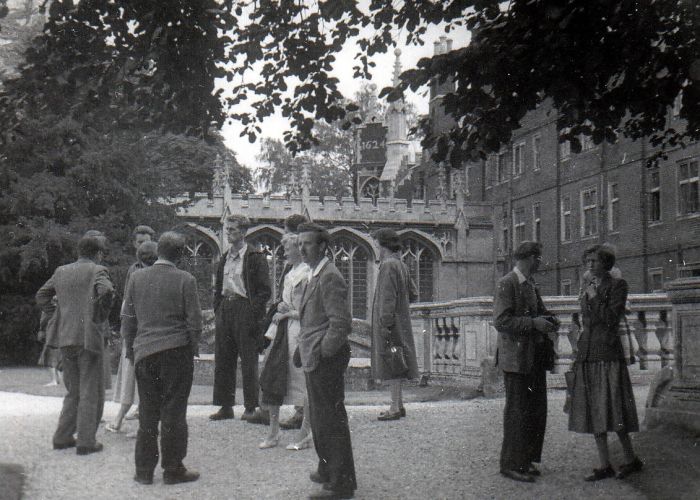
On the trip to Cambridge, the campers were accompanied by Alun Davies, the secretary of the Friends Work Camps Committee in London, who tried his hand at punting after the group had visited St John’s College
On another occasion, the whole group was offered a trip by coach for a day in Cambridge, and the camp ended with a trip to Clacton together with the Seabrookes and the Russell-Howes, which might have offered an opportunity for a swim but which turned out to be a day of storms and gales where Jenny wrote in the log that “the helter-skelter had been ripped from its position and had fallen across the pier and the trippers were standing in sodden and slightly terrified groups”. The outing ended with a traditional seaside fish-and-chip meal before we returned to Hundon to find that one of the girls’ tents had collapsed.
News of the camp spread further than Hundon itself. We were front-page news in the Suffolk Chronicle & Mercury on 6 July, and on the same day there was a long article in the Bury Free Press which was followed up by a set of pictures a week later. I have also heard that there was a report in the Manchester Guardian, but I never saw it. During the final week, two American reporters took a vast number of photographs and notes for a feature article for the American Forces newspaper The Stars and Stripes.
As soon as news of the camp first appeared in the local newspapers, there was a response in the form of a card sent to the “Hundon village hall students” from the Haverhill Young Farmer’s Club, inviting us to join them in a dance on 10 July at the Rose & Crown Hotel in Haverhill, admission 2/6d (=12½p), and a group of nine persons went to this dance thanks to Mr Russell-Howes who provided transport.

Christine waits by the bus

sent to take the campers on a trip round Suffolk villages
Many groups were interested in welcoming the campers and took steps to ensure that the visitors were able to benefit from their stay in England and become acquainted with English culture and history, and on the final Wednesday, the Sudbury Quakers, under the leadership of Mr Hereward Armstrong, invited the campers to a guided coach trip around some of the Suffolk villages including Lavenham and Kersey and ending with tea at the Friends Meeting House in Sudbury.
Contacts between the campers and the local people
Contacts were also established with the villagers on the initiative of the campers.
In order to provide opportunities for the local men to help with the work, several evening work sessions were arranged, but efforts were also made to meet together in less formal social activities

Games with the village children

Local lads eager (?) to help on the building
Already at the end of the first week, an invitation was sent to the local villagers to join us in the evening for a cup of tea and a chat and about fifteen persons including the vicar accepted the invitation.
There was naturally quite a lot of contact with the children and, at the suggestion of some of the young teachers in the group, all the children in the village were invited to a special party on one evening with games in the adjacent field and refreshments in our clubroom.
On the last Friday before the camp ended, the local villagers were invited to a sort of “farewell” party with Jasper in charge of songs and music, and the log written by Yoshi records that about 50 guests joined us, including the Seabrookes, Mr Howes, Mrs Armstrong, the Vicar, the Schoolmaster and “all the prominent people of Hundon”
Lasting results – romance
Eventually, after a month of living together, working together, and talking together, the camp came to an end, the campers dispersed and the signs of the camp disappeared, but in several respects it had lasting results.
One lasting result was of course the village hall, which was eventually completed. Our task was to get a sufficient amount done to inspire the local people to carry on and get it finished.

The village hall as the campers left it at the end of July 1956
The work was certainly continued, but there were still delays and problems and in the following year a second work camp was arranged under the auspices of the Friends Work Camps Committee and, with this added assistance, the building was finally completed and officially opened towards the end of 1957.
The campers kept in touch for some time, but I don’t know for how long these friendships lasted and to what extent people did keep in touch nor to what extent we contributed to world peace, although it may be assumed that each bond of friendship created between persons from different countries and different continents is in its own small way a step forward towards greater understanding and a more peaceful world.
Certainly the experience of having worked together with people from a variety of other nations is something which is not forgotten but which becomes a part of one’s being. Fred, the eldest of the campers, wrote in the log that “there is certainly a wonderful spirit of comradeship in this camp which I have not come across before – this being my first work-camp experience!”
On a more personal and more intimate level, the camp led to romance and several marriages. Certainly Anne-Marie and I married, as did Jasper and Jennifer, and I believe that there were a further two marriages, but I shall refrain from putting names to relationships of which I am not completely certain.

Hundon Village Hall Reunion
The following article appeared in the Haverhill Echo on Thursday May 9th 2013.
History revisited during reunion
BY STEVE BARTON ©steveEcho
The following images were very kindly supplied by Steve Barton and the Haverhill Echo
(Click on pictures for larger images)
Hundon became the venue for an emotional reunion last week when a couple returned from their home in Sweden to see the village hall that they had helped to build 57 years before. Not only had Anne-Marie and Tony Bristow been part of workforce that gave up one month of their lives in the summer of 1956 to construct part of the hall, they also married after striking up a relationship during the project and will this year celebrate their 57th wedding anniversary.
Swedish-born Anne-Marie and her English husband were part of a Friends Work Camp who spent time building the hall between June 30 and July 30, a project that involved 23 volunteers from eight nations, including the UK, US, Sweden, Denmark, Germany, Netherlands, Japan and Switzerland.
All were aged 19 or older, with most, like Anne-Marie and Tony, in their early twenties. Hundon Village Hall had been started in 1955, but difficulties arose and help was called for, bringing about the arrival of the Friends Work Camp, a part of the Friends Service Council, whose aim was to arrange international work camps to bring together young people from different countries. After they had progressed the construction of the hall and moved on, the building was completed in by other parties in 1957 and today it is the hub of village life in Hundon, being used every day of the week by one group or another.
Although Tony and Anne-Marie had made two fleeting visits to Hundon to look at the hall over the years they had not stepped inside and spent any real time there – until last week, when they arrived on Thursday (May 2) a day that the Community Café was held. Their visit was made known to villagers by the Hundon Herald’s editor, Gill Shepstone, after she was in correspondence with 81 year-old Tony.
Tony, a retired research chemist, said: “There are similarities and differences, but the main reaction was excitement to see it is still here and it’s a vital part of village life. “One could imagine that it had been pulled down and used as something else, but it’s still used as a living contribution.
“It’s a feeling of sort of joy and happiness and pleasure that it has been used and what we did in fact was a small effort but it was obviously worthwhile.”
Anne-Marie, now 81 and a retired teacher, added: “At least when you see how much use they’ve made of this hall then you feel you have taken part in something that’s important.”
Tony and Anne-Marie’s return to Hundon to meet villagers and see the hall as it is today was initially inspired by his unearthing of documents and photographs from the cellar of their home in Tullinge, near Stockholm. It brought abut his creation of a booklet about the history of the Friends Work Camp’s part in not just the hall’s construction but also the role its participants played in village life during their month there.
Anne-Marie, a mother of two sons and grandmother of two grandsons, recalled: “A lot of the children were curious. At first they were shy, then they wanted to help. If I was short of a tool they went and found it.”
Along with Geraldine Pearson and Ann Hathaway, Gina Pettitt, 68, was one of three of those children who met Tony and Anne-Marie last week for the first time in 5 7 years.
Gina said: “I can remember her doing things with us and we flocked around her. It was different for us. We were Hundon children bred and born and it was exciting.”


